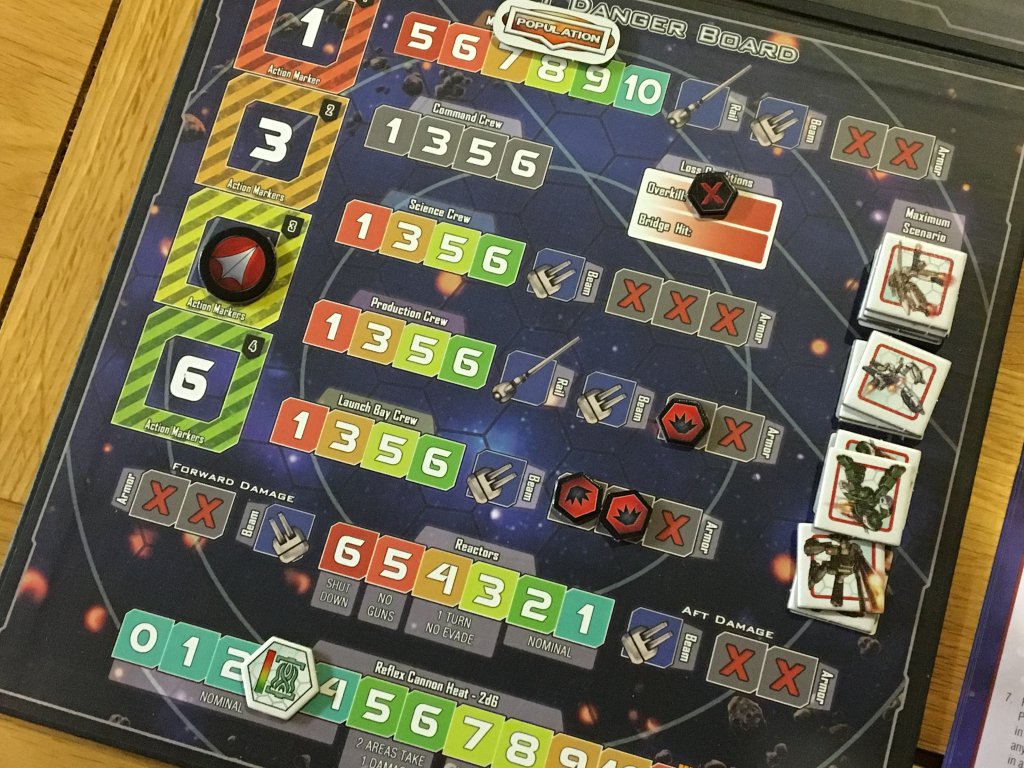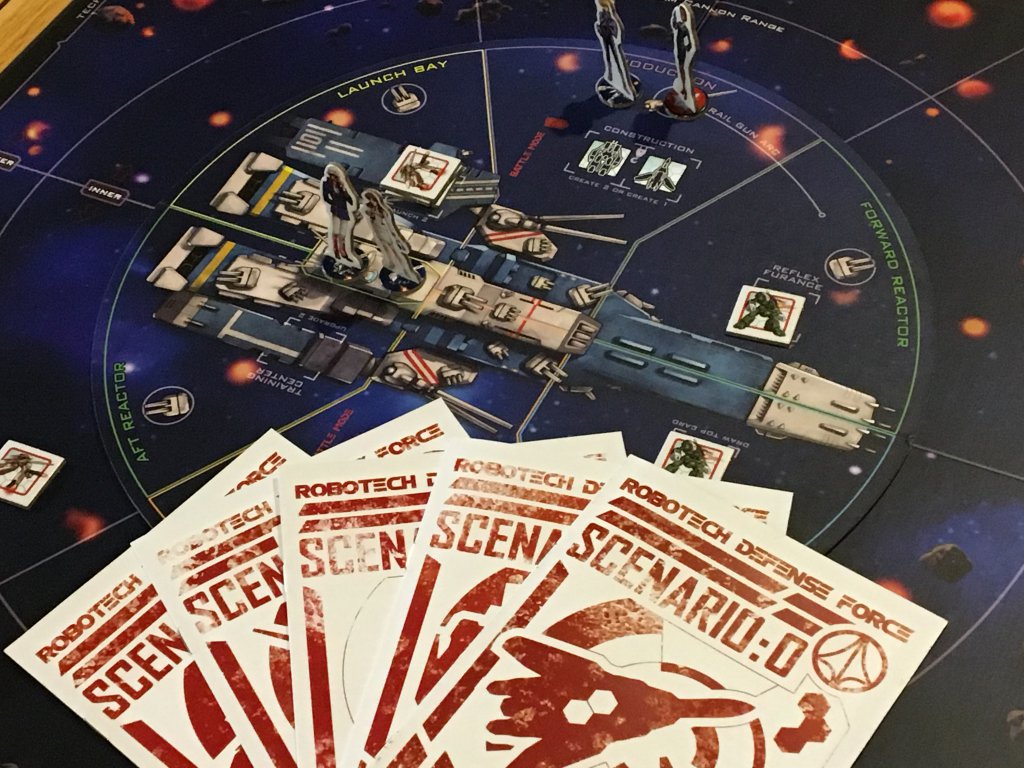Robotech: Attack on the SDF 1 — Anime-zing!
There have been many video game spin offs to accompany the Robotech series since it started, but only a few relatively niche board games — until now, that is. Enter Robotech: Attack on the SDF-1.
The world of Robotech is synonymous with what makes anime great. Giant robots fighting aliens in space, romance, jealousy, tragedy and triumph. Nothing was off limits when it came to entertaining the millions of viewers both in Japan and the West, especially during Robotech’s halcyon days during the 1980’s.
Thanks to fully licensed artwork that brings the original characters to life, as well as a huge board and a lot of components, veteran publisher Japanime Games may have assembled the ingredients to make Robotech relevant to a modern audience. Robotech: Attack on the SDF-1 is a big, complex game — so large in fact that the contents include a replica of the SDF-1’s battle mode — but is bigger, better? SDF-1is a complex beast, so stick with me if you want to learn more about it.
When boiled down, SDF-1 is a cooperative game that is not dissimilar to games like Pandemic, where in the players all work together to defeat a foe that affects them all equally. There are several ways to lose in SDF-1, which may depend on the scenario that you’re playing and what the objective of the nefarious Zentraedi foe is. The difference between Attack and other games in this genre is, without doubt, weight.
The sheer amount of stuff that SDF-1 is supplied with will be enough to make many players baulk. During setup, the players will lay out the components as indicated by the current Scenario, which will then be broken down into Episodes. Each Episode comes with a situation description that explains what is happening thematically, as well as providing a number of unique setup instructions for the gameplay to come.
On average, a game of SDF-1 will take you longer to setup than any other game you own, and with my collection of around three hundred games, I can say that with confidence. For your first few games, this will likely be because the rules are cumbersome and there are so many things to take into account, but later, it’s simply because there is an awful lot to set up and prepare.
A large main board, a circular board that sits on it, hero/crew cards, hundreds of cards across several decks, a bagful of Zentraedi tokens, a thick manual and God knows what else live in this box — and you’ll need to get it all out on the table. Oh, and you’ll need to build that huge model of the SDF-1 in battle mode, just in case you reach the later stages of the given scenario. The scenario itself will inform things like where specific enemies are placed, the population level of the SDF-1 and so on, but those are the simple bits really.
Once the game starts, players will each be managing their own hero (or heroes) including all of the famous faces from the series. Henry, Lisa, Claudia, Rick, Max and Roy are all included, with six playable characters to choose from in total. Other characters like Minmay appear in incident decks or elsewhere. Each playable hero has their own roster of actions which is unique to them, even though the players all basically defeat Zentraedi one way or another.
When the game is actually underway, what matters most about the heroes is where they are located in the SDF-1 (which can affect what actions they can take) and how much population has been assigned to them. The population of the SDF-1 is tracked on a separate “Danger Board” which also maintains a number of tracks for armour, weapon heat and other features that ensure that the SDF-1 remains combat effective.
The population mechanic is an interesting one in that each player will always receive two action points as a minimum, but will then access more of them based on how much of the SDF-1 crew is assigned to them. The more population assigned, the more bonus action points a hero will get, so it’s important that the players discuss this and set up the turn for success. The decision making process here basically being centred around efficiency of actions in the given situation.
The players will then take their turns to perform the hero phase, which involves moving around (and outside) the ship, drawing and using resource cards, using mecha cards and placing mecha tokens in defence of the ship. Some episodes come with specific enemies or conditions that must be overcome, which can lead to the need to use special weapons with specific heroes or similar.
Once the heroes have activated, the Zentraedi will take their turn based on an orders card drawn from the deck. More Zentraedi will be drawn from the bag, whilst others will move into attack position, sometimes whittling down the SDF-1’s Mecha or on other occasions dealing damage more directly. Players can elect for the SDF-1 to take damage to its guns, or directly against its structure, and the heroes are able to repair damage should they have the action points do so.
There are many, many more complex and subtle nuances to gameplay in SDF-1, a lot of which depends on the specific scenario, the heroes in play and so on, as well as the effects of incidents, resources and order cards. I guess the thing is, your desire to persevere through what is a lot of detail, a long setup and a fairly heavy manual will depend on your love of Robotech and your desire to see it recreated in painstaking detail.
If nothing else, SDF-1 really does replicate the feeling of Robotech in its complex, unyielding glory. Nothing at all is left to chance, which is both a blessing and a curse. The SDF-1 experience is unforgiving, providing players with the power to really experience the feeling of a Robotech episode. Moments include everything from the nail-biting feeling of fighting off the Zentraedi to defend a failing system that would mean a certain loss, through to the unexpected loss of a crew member because he is enthralled by another character from the fiction.
For those who have no love of Robotech, SDF-1 would be an odd choice for such players anyway, given the feet first immersion into theme, but this is compounded by how complex the game is at a core, mechanical level. I’m honestly not convinced that SDF-1 is a game that you’ll want to stick with if you’re not a Robotech fan, but if you are?
Well, you may need to stick with it for a while, but there’s a rewarding game here filled with deep and exciting decisions, albeit with perhaps a slant of luck here and there that can result in an unbalanced experience. Yes, I wish there was a better instruction manual and that the core concepts were laid out in a much more sensible way. I even wish that SDF-1 could shed some of its systems and mechanics — several of which feel overly complex. Regardless, Robotech: Attack on the SDF-1 is an interesting title, but do yourself a favour and find someone else to teach it to you!
Robotech: Attack on the SDF-1 is available for purchase now. You can find out more about it here.
Love board games? Check out our list of the top board games we’ve reviewed.







Comments are closed.